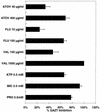Glucuronidation of 3'-azido-3'-deoxythymidine (zidovudine) by human liver microsomes: relevance to clinical pharmacokinetic interactions with atovaquone, fluconazole, methadone, and valproic acid
- PMID: 9660989
- PMCID: PMC105651
- DOI: 10.1128/AAC.42.7.1592
Glucuronidation of 3'-azido-3'-deoxythymidine (zidovudine) by human liver microsomes: relevance to clinical pharmacokinetic interactions with atovaquone, fluconazole, methadone, and valproic acid
Abstract
Zidovudine (3'-azido-3'-deoxythymidine [AZT]), an antiviral nucleoside analog effective in the treatment of human immunodeficiency virus infection, is primarily metabolized to an inactive glucuronide form, GAZT, via uridine-5'-diphospho-glucuronosyltransferase (UGT) enzymes. UGT enzymes exist as different isoforms, each exhibiting substrate specificity. Published clinical studies have shown that atovaquone, fluconazole, methadone, and valproic acid decreased GAZT formation, presumably due to UGT inhibition. The effect of these drugs on AZT glucuronidation was assessed in vitro by using human hepatic microsomes to begin understanding in vitro-in vivo correlations for UGT metabolism. The concentrations of each drug studied were equal to those reported with the usual clinical doses and at concentrations at least 10 times higher than would be expected with these doses. High-performance liquid chromatography was used to assess the respective metabolism and formation of AZT and GAZT. All four drugs exhibited concentration-dependent inhibition of AZT glucuronidation. The respective concentrations of atovaquone and methadone which caused 50% inhibition of GAZT were > 100 and 8 micrograms/ml, well above their usual clinical concentrations. Fluconazole and valproic acid exhibited 50% inhibition of GAZT at 50 and 100 micrograms/ml, which are within the clinical ranges of 10 to 100 and 50 to 100 micrograms/ml, respectively. These data suggest that inhibition of AZT glucuronidation may be more clinically significant with concomitant fluconazole and valproic acid. Factors such as inter- and intraindividual pharmacokinetic variability and changes in AZT intracellular concentrations should be considered as other mechanisms responsible for changes in AZT pharmacokinetics with concomitant therapies.
Figures



References
-
- Anaissie E J, Kontoyiannia D P, Huls C, Vartivarian S E, Karl C, Prince R A, Bosso J, Bodey G P. Safety, plasma concentrations, and efficacy of high-dose fluconazole in invasive mold infections. J Infect Dis. 1995;172:599–602. - PubMed
-
- Bell J, Bowron P, Lewis J, Batey R. Serum levels of methadone in maintenance clients who persist in illicit drug use. Br J Addict. 1990;85:1599–1602. - PubMed
-
- Bertz R J, Granneman G R. Use of in vitro and in vivo data to estimate the likelihood of metabolic pharmacokinetic interactions. Clin Pharmacokinet. 1997;32:210–258. - PubMed
-
- Burchell B, Brierley C H, Rance D. Specificity of human UDP-glucuronosyltransferases and xenobiotic glucuronidation. Life Sci. 1995;57:1819–1831. - PubMed
-
- Clarke D J, Burchell B. The uridine diphosphate glucuronosyltransferase multigene family: function and regulation. In: Kauffman F C, editor. Handbook of experimental pharmacology. Conjugation-deconjugation reactions in drug metabolism and toxicity. Berlin, Germany: Springer-Verlag; 1994. pp. 3–43.
MeSH terms
Substances
LinkOut - more resources
Full Text Sources
Medical

